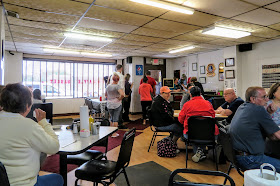…continuing
with the recent visit by Laurie’s sister Bonnie, Bonnie’s husband Bill and
their granddaughter Avery.
The day
after our trip to Tellico Plains and Bald River Falls, we headed out US Hwy.
321 in the direction of Cades Cove, a special place within the Smoky Mountains
National Park that features wildlife viewing.
It was a nice day…still comfortable in the morning…and Avery loves
animals!
So the
big question was…would we get lucky?
There have been times that we visited Cades Cove and we didn’t see any
wildlife.
Our drive
on the 11 mile long Cades Cove Loop road started out on a positive note! It seems that all young girls…or most women
for that matter…love horses. A portion
of the riding stables horses were chilling and relaxing next to the fence by
the road. That made for 3 happy
females! One horse in the second photo
was just trying to scratch an itch…and he looked content.
Europeans
settled Cades Cove ca. 1818 but the Cherokee had established a settlement here
much earlier. It was known as “Tsiya’hi”,
or “Otter Place”. The European name,
Cades Cove, was derived from a Cherokee leader from Tsiya’hi named Chief Kade.
As we
continued our drive we got lucky, spotting this buck standing out in one of the
Cove’s meadows. This early in the year his
antlers were still in velvet…but I think that he was an 8-pointer.
By 1850
the population of Cades Cove grew to 671.
The size of farms in the Cove ranged between 150 and 300 acres. Residents were fairly self-sufficient but
relied on nearby Tuckaleechee Cove for dry goods and other necessities. A post office was established in the Cove in
1933. A weekly mail route was established
in 1839. By sometime in the 1890s,
residents even had phone service after locals built a phone line to Maryville
Tennessee.
I’m sure
that life in Cades Cove was challenging for the residents but my, oh my, what
scenery they woke up to and labored near each day!
Despite
the presence of 3 different churches in the Cove, life wasn’t always peaceful. The 2 Baptist churches were the result of a
schism… Moonshining was a money maker for some residence but anathema for
others.
In 1921,
the Gregory’s still was raided by the Blount County sheriff. The Gregorys blamed the Olivers and the day
after the raid, 2 of the Oliver’s barns were burned, destroying a significant
portion of the family’s livestock and tools.
Then one of the Gregorys was assaulted by 2 of the Sparks family and, in
return, 2 members of the Sparks family were shot on Christmas Eve 1921.
The Gregorys were convicted of the barn
burning as well as of felonious assault…but they were pardoned by Tennessee’s
Governor after 6 months…and he personally escorted them home. (The Gregorys
must have produced some high quality moonshine!)
When we
drive through the cove, we seen honeymooners and wedding parties being
photographed in the Cove…so we took these photos of Avery and her grandparents!
Cades
Cove wasn’t given up easily by its residents.
Cades Cove put up the greatest resistance of any of the mountain
communities in the formation of the Great Smoky Mountains National Park. Originally, they had been assured that their
land wouldn’t be included. But in 1927, with
the approval of funds to buy land for the park, the Park Commission had the
power to seize properties within the park via eminent domain. Death threats to key officials followed as
did lengthy court battles. Defeated,
John Oliver was the last resident to abandon his property on Christmas Day in
1937.
There are
a number of historic buildings still standing within Cades Cove that are
maintained by the National Park Service.
The photo above shows the Becky Cable House (1879).
Other
buildings in the Cove include: John Oliver Cabin (1822 – 1823); Primitive
Baptist Church (1887); Cades Cove Methodist Church (1902); Cades Cove
Missionary Baptist Church (1915 – 1916); The Myers Barn (1920); Elijah Oliver
Place (1866); John Cable Grist Mill (1868); Henry Whitehead Cabin (ca. 1895);
Dan Lawson Place (1840s); The Tipton Place (1880s), and Carter Shields Cabin
(1880s).
Note:
· Parishioners from the Primitive Baptist Church
defied the National Park Service and that organization’s plans for many years, continuing
to meet at their church in the Cove until the 1960s.
Here are a couple more views of this beautiful place.
Amazingly, the park and the loop drive wasn’t packed with tourists on
this spectacular morning. Cades Cove is
the single most popular destination for visitors to the Great Smoky Mountains
National Park. Its scenery, well
preserved historic structures and its display of wildlife draws over 5,000,000
visitors every year!
Of
course, as regards the wildlife, traffic flow, time of the day, timing on your
drive, ability to spot animals along the route and luck are all critical for
visitors.
So…at
least for Avery’s sake, did we get lucky?
Yes we did! Laurie captured several photos of a nice size
black bear feeding in the brush fairly close to the road. An adult male American black bear can weigh
up to about 500 lbs. and a female can reach about 375 lbs. Most of our previous bear sightings here have been
at long distance or up in a tree.
You’d
think that they’d be seen more often!
After all, about 1,500 black bears live in the Great Smoky Mountains
National Park. That equals about 2 bears
per square mile. That’s the reason that
we often have local reports, especially early in the spring when food is
scarce, of bears in town and near homes…just looking for something to eat.
That’s
about it for now… Just click on any of the photos to enlarge them.
Thanks
for stopping by for a visit!
Take
Care, Big Daddy Dave


















































